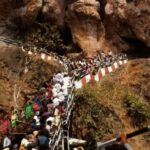A tribe denotes a community bound by shared ancestry and culture, often choosing to live in closed societies. In India, the tribes represent indigenous or native populations dispersed across the nation, contributing significantly to our intangible national heritage. Recognizing their importance, this article sheds light on key tribes in India.
Key Questions:
Before delving into the details of major Indian tribes, you can find answers to common questions about tribal communities in India:
- Who are Tribal People?
- Who is India’s Tribal Minister?
- What are the main problems faced by Tribal communities?
- What is the classification of Tribal communities?
The Tribal Population of India
Tribal populations are dispersed throughout the Indian mainland, with notable concentrations in Mizoram, Lakshadweep, Meghalaya, and Nagaland. States like Madhya Pradesh, Orissa, Maharashtra, Rajasthan, Chhattisgarh, Assam, and West Bengal also host significant tribal settlements. Nationally, scheduled tribes constitute 8.6% of the total population. As of Article 342 of the Indian constitution, over 700 tribes are officially recognized, spanning various states and union territories.
Prominent Tribes of India
Noteworthy among the tribes are the Gonds, Bhils, Santhal, Munda, Khasi, Garo, Angami, Bhutia, Chenchu, Kodaba, and the Great Andamanese Tribes. The Bhil tribe, comprising 38% of the scheduled tribal population, stands out as the largest tribe in India, known for its distinctive Bhil Art portraying everyday life and deities.
The Gond Tribe
Following closely, the Gond tribe ranks as the second-largest tribe, spread across states like Andhra Pradesh, Telangana, Maharashtra, Bihar, and Orissa. With a population exceeding four million, the Gond tribe constitutes 35.6% of the country’s total tribal population.
Literacy Among Tribal People
Recognizing the importance of education, the Government of India introduced reservation schemes to uplift tribal literacy rates. From a mere 8.5% in 1961, the literacy rate among tribal communities rose to 63.1% in 2011. However, challenges persist, including economic hardships and limited access to education due to remote locations.
Related Articles
Initiatives and Challenges
To address these challenges, NGOs and groups are working to establish schools in remote tribal villages, promoting education in native languages, and providing essential resources. The Tribal Cooperative Marketing Development Federation of India (TRIFED), founded in 1978, plays a pivotal role in the social and economic upliftment of tribal communities.
Conclusion
Tribal people are integral to Indian culture, and it is imperative for the government to take proactive steps in preserving their heritage and improving living conditions through education and sustainable development initiatives.

1 thought on “Exploring the Rich Tapestry of India’s Tribal Communities”